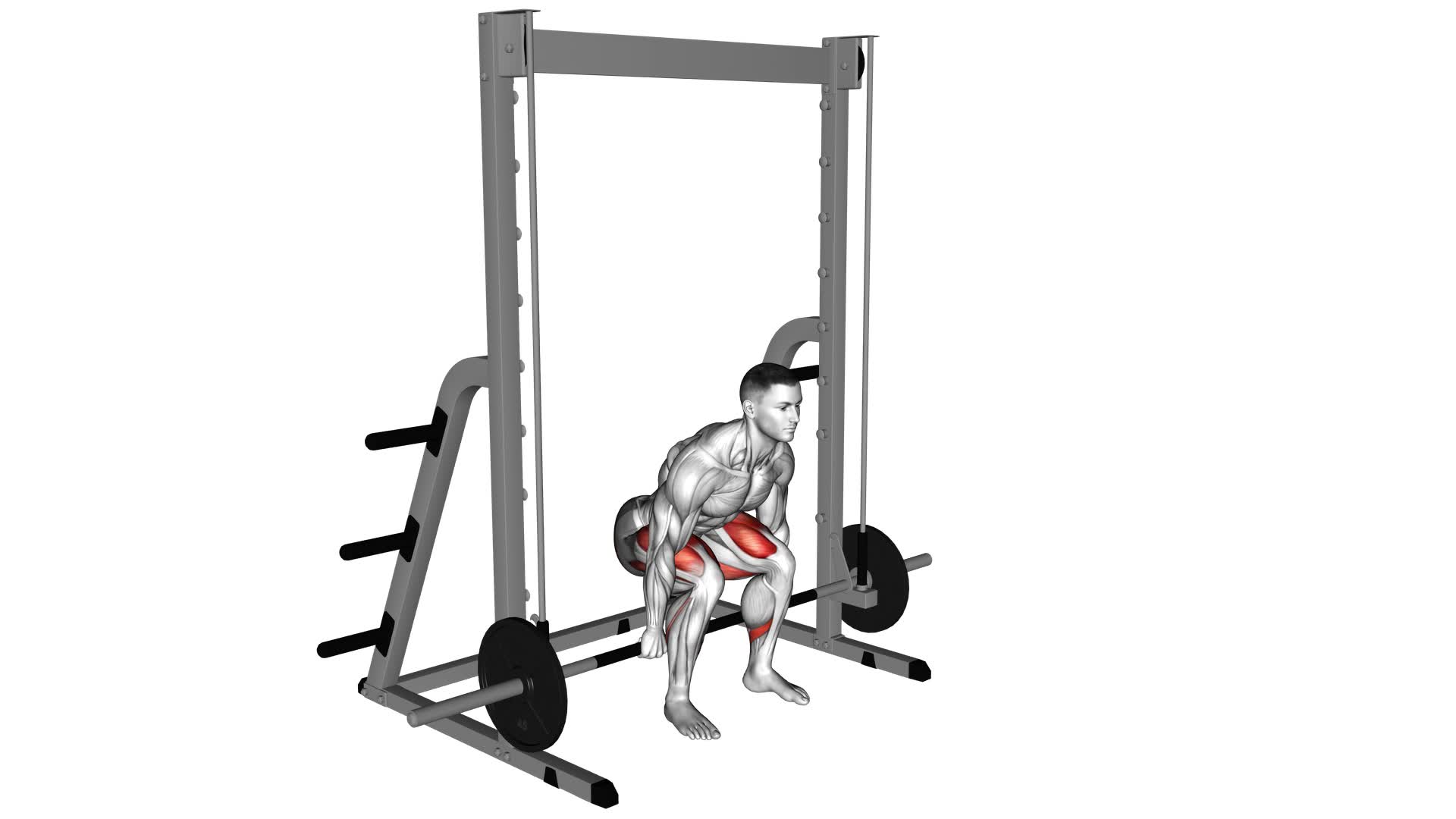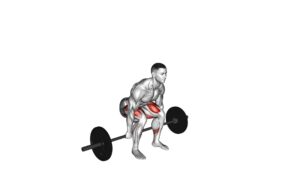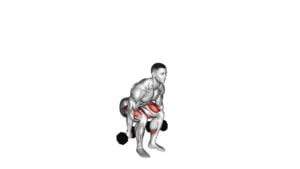Smith Hack Squat – Video Exercise Guide & Tips

Looking to improve your leg strength and build muscle? Check out our Smith Hack Squat video exercise guide and tips! In this article, we'll show you the proper form and technique, how to set up the Smith machine, and the key muscles targeted.
Watch This Exercise Video
Plus, we'll cover variations, common mistakes to avoid, and tips for maximizing your results.
Get ready to take your leg workouts to the next level with this effective exercise!
Key Takeaways
- Proper form and technique are crucial for performing the Smith Hack Squat effectively and safely.
- The Smith Hack Squat targets the quadriceps, hamstrings, and glutes, which improves lower body power and stability.
- Variations and modifications, such as goblet squats, sumo squats, Bulgarian split squats, and using different equipment like barbells or kettlebells, can increase muscle engagement and add variety to the squat routine.
- Incorporating different variations and modifications can help prevent injuries by strengthening muscles, joints, and connective tissues, while also maximizing the effectiveness of squat workouts.
Proper Form and Technique
How can you ensure proper form and technique while performing the Smith Hack Squat exercise? To maximize gains and prevent injury, it's crucial to focus on proper form and technique during this exercise.
Firstly, start by standing with your feet shoulder-width apart and position yourself under the barbell on the Smith machine. As you grip the bar with an overhand grip, ensure that your hands are slightly wider than shoulder-width apart.
Next, bend your knees and lower your body into a squatting position while keeping your back straight and your chest up. It's important to maintain control throughout the movement and avoid any jerking or bouncing motions.
As you push through your heels, extend your legs and return to the starting position. Remember to breathe steadily throughout the exercise, exhaling as you push up. By following these proper form and technique guidelines, you can maximize your gains and reduce the risk of injury.
Now, let's move on to the next section and discuss how to set up the Smith machine.
Setting Up the Smith Machine
To properly set up the Smith machine for the Smith Hack Squat exercise, follow these steps:
- Position yourself under the barbell on the machine, using the correct grip and stance discussed in the previous section.
- Adjusting the height: Locate the height adjustment mechanism on the Smith machine. It's usually a lever or pin that allows you to change the position of the barbell. Release the lever or remove the pin and slide the barbell up or down until it's at a level that allows you to comfortably perform the exercise while maintaining proper form. Make sure the barbell isn't too high or too low, as this can affect your range of motion and potentially lead to injury.
- Proper foot placement: Stand with your feet shoulder-width apart and position them slightly in front of the barbell. This will ensure that your knees and hips are aligned properly and that you have a stable base of support. You can also experiment with different foot positions to target different muscles during the exercise.
Key Muscles Targeted
By targeting specific muscles, the Smith Hack Squat exercise helps improve lower body strength and stability. This compound movement primarily targets the quadriceps, hamstrings, and glutes. The quadriceps, located at the front of the thigh, are responsible for knee extension. By engaging them during the Smith Hack Squat, you're maximizing muscle growth in this area.
The hamstrings, located at the back of the thigh, play a crucial role in knee flexion and hip extension. By working the hamstrings during this exercise, you're strengthening the posterior chain and promoting balanced lower body development.
Additionally, the glutes, which are the largest muscle group in the body, are also engaged during the Smith Hack Squat. Strengthening the glutes not only enhances lower body power and stability but also aids in injury prevention techniques. Strong glutes can help reduce the risk of knee and lower back injuries by providing stability and support to these areas.
By targeting these key muscles, the Smith Hack Squat exercise allows you to develop a well-rounded lower body and improve overall athletic performance.
Now that you understand the muscles targeted, let's explore some variations and modifications of the Smith Hack Squat.
Variations and Modifications
Now let's talk about the variations and modifications you can incorporate into your Smith Hack Squat routine.
There are different squat techniques you can try to target specific muscle groups and add variety to your workouts.
Additionally, you have the option to use different equipment, such as resistance bands or a weighted vest, to modify the intensity of the exercise.
Exploring these variations and modifications can help you challenge your muscles in new ways and maximize the benefits of your Smith Hack Squat routine.
Different Squat Techniques
Explore various squat techniques and modifications to enhance your workout and target different muscle groups. Here are three different squat variations that you can try:
- Goblet Squats: Hold a dumbbell or kettlebell close to your chest, and perform squats. This variation helps improve your core strength and stability.
- Sumo Squats: Stand with your feet wider than hip-width apart and toes pointed outwards. Squat down, keeping your knees in line with your toes. This variation targets your inner thighs and glutes.
- Bulgarian Split Squats: Stand with one foot forward and the other foot elevated behind you on a bench or step. Lower your body into a lunge position, keeping your front knee directly above your ankle. This variation activates your quads and glutes while improving balance and stability.
Equipment Options for Modifications
To modify and vary your squat exercises, you can utilize different equipment options. These options provide you with the opportunity to challenge yourself and target different muscle groups.
One equipment option you can use is the barbell. By adding weight plates to the barbell, you can increase the intensity of your squats.
Another option is the kettlebell. Holding a kettlebell in front of your chest while squatting can help improve your upper body strength.
Additionally, you can use a resistance band to add resistance to your squats. Simply place the band around your thighs or ankles and perform the squats as usual.
These equipment options provide you with plenty of modification ideas to keep your squat workouts challenging and effective.
Benefits of Variations
To maximize the effectiveness of your squat workouts, it's important to understand the benefits of incorporating variations and modifications. Different squat variations can target different muscle groups and provide unique challenges to your body.
Here are three benefits of incorporating variations into your squat routine:
- Increased muscle engagement: By trying different squat variations such as sumo squats or Bulgarian split squats, you can target specific muscles like your inner thighs or glutes, leading to greater muscle activation and growth.
- Improved strength and stability: Adding variations like front squats or pistol squats can help improve your overall strength and stability by challenging your core and balance.
- Injury prevention: By practicing proper form in different squat variations, you can strengthen your muscles, joints, and connective tissues, reducing the risk of injury during other physical activities.
Incorporating variations into your squat routine not only adds variety and excitement but also helps you achieve your fitness goals more effectively. Remember to always prioritize proper form to maximize the benefits of your squats and minimize the risk of injury.
Common Mistakes to Avoid
When performing the Smith Hack Squat, it's crucial to maintain proper form to avoid injury and maximize muscle activation.
To ensure correct form, make sure your feet are shoulder-width apart, your knees are in line with your toes, and your back is straight throughout the movement.
Additionally, be mindful of not using momentum or leaning too far forward, as this can compromise the effectiveness of the exercise.
Proper Form Importance
Maintain proper form to maximize the benefits and prevent common mistakes while performing the Smith Hack Squat. Here are some important tips to help you achieve the best results and avoid injuries:
- Feet placement: Position your feet shoulder-width apart and slightly angled outward. This will provide stability and engage the correct muscles.
- Back alignment: Keep your back straight throughout the exercise. Avoid rounding or arching your back, as this can lead to strain or injury.
- Depth of squat: Lower yourself until your thighs are parallel to the ground. Going too low can put unnecessary stress on your knees, while not going low enough will reduce the effectiveness of the exercise.
By following these form guidelines, you'll maximize your performance and minimize the risk of injury.
Now, let's move on to some injury prevention tips.
Injury Prevention Tips
To avoid common mistakes and prevent injuries while performing the Smith Hack Squat, it's crucial that you pay attention to proper form and follow these injury prevention tips.
First and foremost, make sure to warm up properly before starting your workout. This could include dynamic stretches, such as leg swings and hip circles, to increase blood flow to the muscles and prepare them for the exercise.
Additionally, incorporating recovery strategies into your routine is essential for injury prevention. This can involve foam rolling or using a massage ball to release tension in the muscles, as well as adequate rest days to allow your body to recover and repair.
Maximizing Muscle Activation
To maximize muscle activation and prevent potential mistakes, focus on maintaining proper form and technique while performing the Smith Hack Squat. Here are three important tips for optimizing your workout efficiency and implementing effective muscle building strategies:
- Keep your feet shoulder-width apart and flat on the platform. This will ensure proper stability and balance throughout the exercise.
- Lower your body by bending your knees and hips, while keeping your back straight and chest up. Avoid excessive forward lean or rounding of the back, as this can increase the risk of injury and reduce muscle activation.
- Push through your heels as you extend your knees and hips to return to the starting position. This will engage your quadriceps, hamstrings, and glutes more effectively, maximizing muscle activation.
By following these guidelines, you can enhance your muscle building efforts and optimize the efficiency of your Smith Hack Squat workout.
Now, let's move on to some additional tips for maximizing your results.
Tips for Maximizing Your Results
To maximize your results, implement these 5 key tips during your Smith Hack Squat workouts.
- Warm-up adequately: Before starting your Smith Hack Squat routine, make sure to warm up your muscles with dynamic stretches and light cardio exercises. This will help increase blood flow to the muscles, reduce the risk of injury, and enhance muscle activation during your workout.
- Maintain proper form: Focus on maintaining proper form throughout the exercise. Keep your back straight, chest up, and knees aligned with your toes. Avoid rounding your back or letting your knees cave inwards. This won't only prevent injuries but also ensure that your muscles are effectively targeted.
- Gradually increase weight: As you progress in your training, gradually increase the weight you use for Smith Hack Squats. This progressive overload will challenge your muscles, leading to growth and improved results over time.
- Control the descent: Slowly lower the weight during the eccentric phase of the exercise. This controlled descent not only enhances muscle activation but also reduces the risk of injury.
- Listen to your body: Pay attention to any discomfort or pain during the exercise. If you experience sharp pain or feel excessive strain on your joints, stop immediately and seek guidance from a qualified fitness professional.
By following these tips, you can maximize your results from Smith Hack Squats while minimizing the risk of injury and enhancing muscle activation.
Remember to stay consistent, push yourself within your limits, and always prioritize safety during your workouts.
Frequently Asked Questions
How Many Sets and Repetitions Should I Do When Performing the Smith Hack Squat Exercise?
When performing the Smith Hack Squat exercise, it's important to consider the number of sets and repetitions.
The ideal number of sets and repetitions can vary depending on your fitness goals and current fitness level.
It's generally recommended to start with 3-4 sets of 8-12 repetitions. This will help build strength and muscle endurance.
As you progress, you can increase the number of sets or reps to continue challenging your muscles.
Can the Smith Hack Squat Exercise Be Modified for Individuals With Knee or Back Pain?
If you're experiencing knee or back pain, don't worry! There are modifications and alternatives you can try for the Smith Hack Squat exercise.
It's important to prioritize your safety and comfort. Consult with a fitness professional or physical therapist to determine the best modifications for your specific needs.
They may recommend adjusting the range of motion, using lighter weights, or exploring other exercises that target the same muscle groups.
Remember to listen to your body and make adjustments accordingly.
Is It Necessary to Use a Spotter When Performing the Smith Hack Squat Exercise?
When performing the Smith Hack Squat, it's important to consider whether or not you need a spotter. While it isn't necessary to have a spotter for this exercise, having one can provide extra support and ensure your safety.
However, if you feel confident in your ability to perform the exercise without a spotter, you can still do so. Remember to always listen to your body and make modifications if needed, such as using lighter weights or adjusting the range of motion.
Can the Smith Hack Squat Exercise Be Performed Using Free Weights Instead of a Smith Machine?
Yes, the Smith hack squat exercise can be performed using free weights instead of a Smith machine. However, the Smith machine offers certain benefits such as stability and control, which can be beneficial for beginners or those with limited strength or mobility.
Using free weights, such as barbells or dumbbells, provides a more challenging and functional workout, engaging stabilizer muscles.
It's important to choose the option that aligns with your fitness goals and abilities.
Are There Any Specific Warm-Up Exercises Recommended Before Starting the Smith Hack Squat Exercise?
Before starting the Smith Hack Squat exercise, it's important to perform specific warm-up exercises to prepare your muscles and joints. These warm-up exercises should focus on increasing blood flow, improving flexibility, and activating the muscles that will be utilized during the smith hack squat. By doing so, you can reduce the risk of injury and enhance your performance during the exercise.
Additionally, the smith hack squat exercise offers numerous benefits, including targeting the quadriceps, hamstrings, and glutes, while also improving overall lower body strength and stability.
Conclusion
In conclusion, the Smith hack squat is an effective exercise for targeting multiple muscle groups, including the quadriceps, hamstrings, and glutes.
By maintaining proper form and technique, setting up the Smith machine correctly, and avoiding common mistakes, you can maximize your results and minimize the risk of injury.
Remember to consult with a fitness professional to ensure proper execution and to tailor the exercise to your individual needs and abilities.
Keep pushing yourself and enjoy the benefits of this challenging workout.

Author
Years ago, the spark of my life’s passion ignited in my mind the moment I stepped into the local gym for the first time. The inaugural bead of perspiration, the initial endeavor, the very first surge of endorphins, and a sense of pride that washed over me post-workout marked the beginning of my deep-seated interest in strength sports, fitness, and sports nutrition. This very curiosity blossomed rapidly into a profound fascination, propelling me to earn a Master’s degree in Physical Education from the Academy of Physical Education in Krakow, followed by a Sports Manager diploma from the Jagiellonian University. My journey of growth led me to gain more specialized qualifications, such as being a certified personal trainer with a focus on sports dietetics, a lifeguard, and an instructor for wellness and corrective gymnastics. Theoretical knowledge paired seamlessly with practical experience, reinforcing my belief that the transformation of individuals under my guidance was also a reflection of my personal growth. This belief holds true even today. Each day, I strive to push the boundaries and explore new realms. These realms gently elevate me to greater heights. The unique combination of passion for my field and the continuous quest for growth fuels my drive to break new ground.







